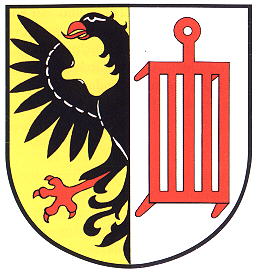Lunden: Difference between revisions
Knorrepoes (talk | contribs) m (Text replace - "'''Origin/meaning :'''<br/> The" to "====Origin/meaning==== The") |
Knorrepoes (talk | contribs) m (Text replace - "[[Literature" to "{{media}} [[Literature") |
||
| Line 28: | Line 28: | ||
|align="center"|[[File:lunden.hagd.jpg|center]] <br/>The arms in the [[Kaffee Hag albums]] +/- 1925 | |align="center"|[[File:lunden.hagd.jpg|center]] <br/>The arms in the [[Kaffee Hag albums]] +/- 1925 | ||
|} | |} | ||
{{media}} | |||
[[Literature]] : Hupp, O: [[Kaffee Hag albums]], 1920s; Reissmann, 1997 | [[Literature]] : Hupp, O: [[Kaffee Hag albums]], 1920s; Reissmann, 1997 | ||
Revision as of 01:07, 9 July 2014
| Heraldry of the World Civic heraldry of Germany - Deutsche Wappen (Gemeindewappen/Kreiswappen) |
LUNDEN
State : Schleswig-Holstein
District (Kreis) : Dithmarschen
Amt : Amt Kirchspielslandgemeinde Eider (until 2008 Amt Kirchspielslandgemeinde Lunden)
Official blazon
Gespalten. Vorn in Gold ein rotbewehrter, schwarzer halber Adler am Spalt, hinten in Silber ein mit dem Griff nach oben gestellter roter Rost.
Origin/meaning
The arms were granted on April 19, 1988.
The arms were probably originally granted when Lunden received city rights in 1529. These were retracted in 1559 and Lunden did not develop into a proper city. The arms are seen in a manuscript from 1592. The eagle is the Imperial eagle and was used by the free villages and cities of Dithmarschen to indicate that they were only subjected to the Emperor himself. Also the Wurtmann clan in the 16th century used a demi-eagle in their arms. With Peter Swyn and Peter Nanne the clan played a major role in the development into a city.
The grill is the symbol of St. Lawrence, the local patron saint.
| The arms in the Kaffee Hag albums +/- 1925 |
Contact and Support
Partners:
Your logo here ?
Contact us
© since 1995, Heraldry of the World, Ralf Hartemink 
Index of the site
Literature : Hupp, O: Kaffee Hag albums, 1920s; Reissmann, 1997












